A Reckoning is Upon Us | The Populist Movement in America
An Op-Ed by The Outlaw Urbanist
Something is happening in America…
Many people do not understand it. Some people fear it. Other people recognize it as something long overdue.
Populism has washed ashore in America with a terrible thunder…
The Establishment brought this upon themselves. By ‘the establishment’, we generally mean the media, political, and moneyed-interest class principally, but not exclusively, located in New York, Washington, D.C. and Los Angeles. This is the real us vs. them dynamic in play in this election since political affiliation, race, gender, age or any other way ‘them’ attempt to divide (and conquer) ‘us’ is irrelevant.
The Establishment has faced a successive wave of ‘change’ elections: Republicans lost control of the U.S. Congress in 2006; Republicans lost control of the White House in 2008; Democrats lost control of the U.S. House of Representatives in 2010; President Obama was re-elected in 2012 even as Republicans dramatically increased control of the U.S. Congress and states governorships/legislatures from 2010-2014; and, Democrats lost control of the U.S. Senate in 2014.
The American people are speaking loud and clear: the medium is the message.
And yet, the Establishment still refuses to listen. Yes, the American people are angry. I understand the anger. Too often, I have watched people – lacking in common sense but blessed with an abundance of money, influence, and willful ignorance – change the rules in their own petty self-interests at the expense of others who worked hard and deserved to rise in a functional meritocracy.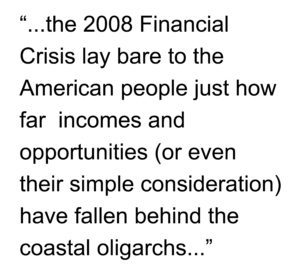
It is true there have always been ‘insiders’ and ‘outsiders’ in the capitalism of the American republic. This is accepted as a given. However, the bailouts of the 2008 Financial Crisis lay bare to the American people just how far incomes and opportunities (or even their simple consideration) have fallen behind the coastal oligarchs. The ‘opium drip’ of Qualitative Easing and zero interest rates to prop up the banks and real estate/financial markets over the last seven years has not allowed the pulling back of the curtain in 2008 to recede into a forgotten past. They have enriched themselves beyond all measure while we continue to struggle day-to-day to find jobs, feed ourselves, and pay our bills (the proverbial “income inequality”). In particular, Black Americans (especially urban youth) have paid a terrible, unfair price for this status quo, which should be viewed as a complete disgrace by any citizen possessing the tiniest measure of decency. The solution is not found in a barely disguised democratic socialism. Nor it is found in an unmasked laissez-faire capitalism. It can be found in a common sense republicanism; the historic source of American meritocracy when functioning properly.
This anger is feeding populist movements on the extreme left of the Democratic Party (“feel the Bern”) and the muddled right of the Republican Party (“win again”). The origins of both movements are tapped from the same vein whether expressed in the Occupy Wall Street or Tea Party protests of the not-so-distant past. These movements are natural allies, both sides of the same coin, and supporters of each should avoid the all-too-obvious efforts of the Establishment (for example, George Soros and MoveOn.org) to pit either side against each other in a cage match designed to create a conflagration of mutual-consumption. It is an insidious effort to re-assert the bought privileges of a select few by ensuring the election of Hillary Clinton, who could not be a more potent symbol of the Establishment if she tried.
Common cause is what really scares the Establishment. They are coming to realize that many (not all) of Bernie Sanders’ supporters will cross over and vote for Donald J. Trump in the November election to defeat their ‘potent symbol’ as the youth vote in President Obama’s coalition sits this election out because their preferred messenger never had a realistic chance in the rigged Democratic primaries (all pay homage to the Super Delegates and biased media). They are coming to realize the ‘conventional wisdom’ of the electoral map will be utterly destroyed and re-drawn anew in the process. The silent majority of Americans – including many people such as myself who, out of frustration, now refuse to participate at all – watch in delighted glee as the Establishment (especially the media, be it of the FOX News, CNN or MSNBC variety) squirms in desperate discomfort to ignore, desperate attempt to blunt, and desperate wish to avoid the inevitable.
A reckoning is upon us and you better start listening or else the Establishment is “gonna wonder how (they) ever thought (they) could live so large and leave so little for the rest of us.”
And if this isn’t the time? If not today, then tomorrow.


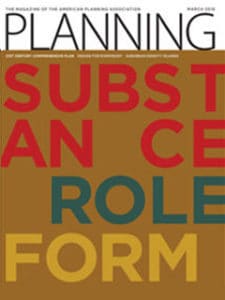 Planning Naked | March 2016
Planning Naked | March 2016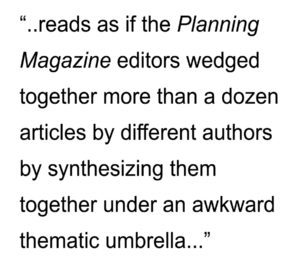 That’s not to say there aren’t good, interesting items in here (there are) but it’s a chore to sort through the mess and the constant “take (insert ‘community name/plan’ here)” asides are irritating in the extreme. It’s like someone composed a checklist, which can be re-constructed based on these paragraph ‘take this example’ asides. Let me try to help the readers: pp. 14-19 is ‘buzzword’ fluff that reads like a committee of marketing agencies wrote it (ignore it unless you find yourself in need of action verbs); pp. 20-24 (to the first 2 paragraphs) is outstanding because it demonstrates the re-emergence of design (e.g. form-based codes, etc.) as the real driver of new approaches to comprehensive plans and, in typical APA fashion, the awkward structure is designed to subvert the real story in order to re-assert (or, perhaps, soften the blow to) traditional planning approaches in the post-war period; the rest of the content (pp. 24-31) is mostly more planning fluff and buzzwords except for isolated excerpts here and there about PlanLafayette.
That’s not to say there aren’t good, interesting items in here (there are) but it’s a chore to sort through the mess and the constant “take (insert ‘community name/plan’ here)” asides are irritating in the extreme. It’s like someone composed a checklist, which can be re-constructed based on these paragraph ‘take this example’ asides. Let me try to help the readers: pp. 14-19 is ‘buzzword’ fluff that reads like a committee of marketing agencies wrote it (ignore it unless you find yourself in need of action verbs); pp. 20-24 (to the first 2 paragraphs) is outstanding because it demonstrates the re-emergence of design (e.g. form-based codes, etc.) as the real driver of new approaches to comprehensive plans and, in typical APA fashion, the awkward structure is designed to subvert the real story in order to re-assert (or, perhaps, soften the blow to) traditional planning approaches in the post-war period; the rest of the content (pp. 24-31) is mostly more planning fluff and buzzwords except for isolated excerpts here and there about PlanLafayette.

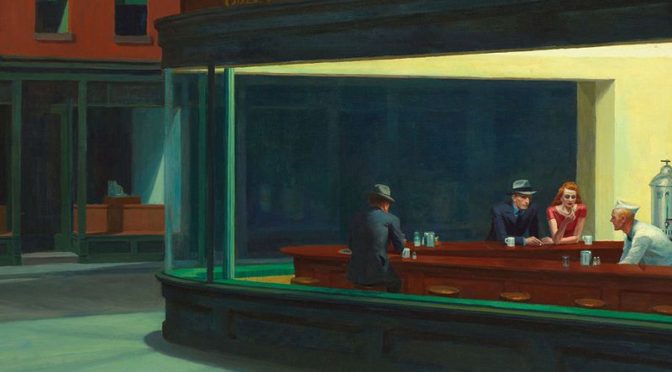
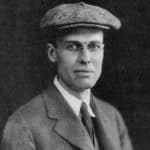 Edward Hopper (July 22, 1882 – May 15, 1967) was a prominent American realist painter and printmaker (Source: Wikipedia). Born in 1882, Edward Hopper trained as an illustrator and devoted much of his early career to advertising and etchings. Influenced by the Ashcan School and taking up residence in New York City, Hopper began to paint the commonplaces of urban life with still, anonymous figures, and compositions that evoke a sense of loneliness. His famous works include House by the Railroad (1925), Automat (1927) and the iconic Nighthawks (1942). Hopper died in 1967 (Source: Biography.com).
Edward Hopper (July 22, 1882 – May 15, 1967) was a prominent American realist painter and printmaker (Source: Wikipedia). Born in 1882, Edward Hopper trained as an illustrator and devoted much of his early career to advertising and etchings. Influenced by the Ashcan School and taking up residence in New York City, Hopper began to paint the commonplaces of urban life with still, anonymous figures, and compositions that evoke a sense of loneliness. His famous works include House by the Railroad (1925), Automat (1927) and the iconic Nighthawks (1942). Hopper died in 1967 (Source: Biography.com).